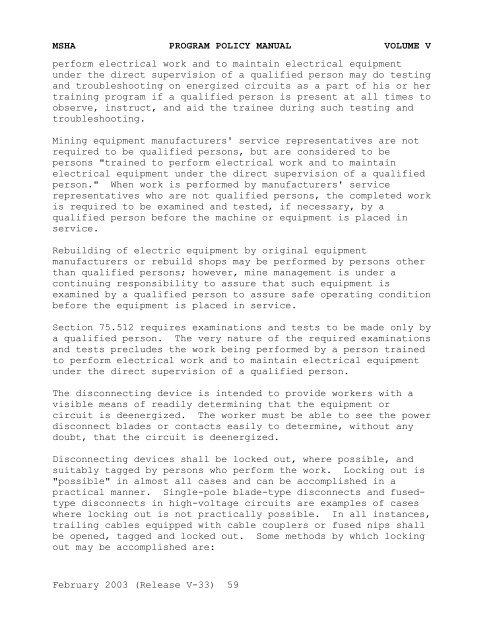Program Policy Manual - VOLUME V - Mine Safety and Health ...
Program Policy Manual - VOLUME V - Mine Safety and Health ...
Program Policy Manual - VOLUME V - Mine Safety and Health ...
Create successful ePaper yourself
Turn your PDF publications into a flip-book with our unique Google optimized e-Paper software.
MSHA PROGRAM POLICY MANUAL <strong>VOLUME</strong> V<br />
perform electrical work <strong>and</strong> to maintain electrical equipment<br />
under the direct supervision of a qualified person may do testing<br />
<strong>and</strong> troubleshooting on energized circuits as a part of his or her<br />
training program if a qualified person is present at all times to<br />
observe, instruct, <strong>and</strong> aid the trainee during such testing <strong>and</strong><br />
troubleshooting.<br />
Mining equipment manufacturers' service representatives are not<br />
required to be qualified persons, but are considered to be<br />
persons "trained to perform electrical work <strong>and</strong> to maintain<br />
electrical equipment under the direct supervision of a qualified<br />
person." When work is performed by manufacturers' service<br />
representatives who are not qualified persons, the completed work<br />
is required to be examined <strong>and</strong> tested, if necessary, by a<br />
qualified person before the machine or equipment is placed in<br />
service.<br />
Rebuilding of electric equipment by original equipment<br />
manufacturers or rebuild shops may be performed by persons other<br />
than qualified persons; however, mine management is under a<br />
continuing responsibility to assure that such equipment is<br />
examined by a qualified person to assure safe operating condition<br />
before the equipment is placed in service.<br />
Section 75.512 requires examinations <strong>and</strong> tests to be made only by<br />
a qualified person. The very nature of the required examinations<br />
<strong>and</strong> tests precludes the work being performed by a person trained<br />
to perform electrical work <strong>and</strong> to maintain electrical equipment<br />
under the direct supervision of a qualified person.<br />
The disconnecting device is intended to provide workers with a<br />
visible means of readily determining that the equipment or<br />
circuit is deenergized. The worker must be able to see the power<br />
disconnect blades or contacts easily to determine, without any<br />
doubt, that the circuit is deenergized.<br />
Disconnecting devices shall be locked out, where possible, <strong>and</strong><br />
suitably tagged by persons who perform the work. Locking out is<br />
"possible" in almost all cases <strong>and</strong> can be accomplished in a<br />
practical manner. Single-pole blade-type disconnects <strong>and</strong> fusedtype<br />
disconnects in high-voltage circuits are examples of cases<br />
where locking out is not practically possible. In all instances,<br />
trailing cables equipped with cable couplers or fused nips shall<br />
be opened, tagged <strong>and</strong> locked out. Some methods by which locking<br />
out may be accomplished are:<br />
February 2003 (Release V-33) 59
















